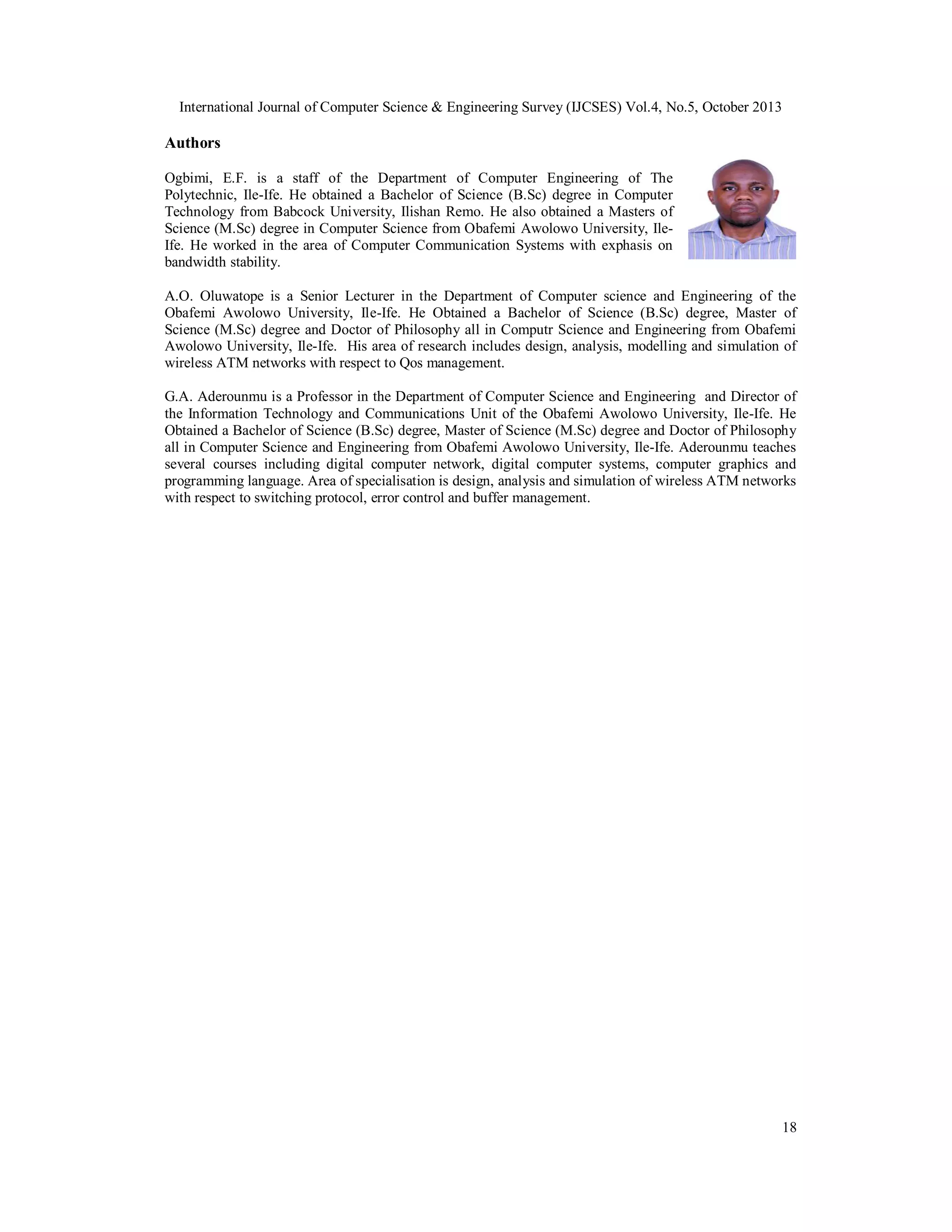The paper addresses congestion control in packet-switched wide area networks (WAN) by proposing a dynamic explicit feedback model that stabilizes bandwidth flow, minimizing packet drops and improving network performance. Utilizing control and queuing theory, the model enhances packet transmission stability amidst varying user demands and mitigates congestion caused by traditional protocols. Simulations using MATLAB demonstrated the effectiveness of the model in achieving fair bandwidth distribution and reducing oscillations in network behavior.
![International Journal of Computer Science & Engineering Survey (IJCSES) Vol.4, No.5, October 2013
Congestion Control in Packet Switched Wide Area
Networks using a Feedback Model
Ogbimi, E.F.1, A.O. Oluwatope1, and G.A. Aderounmu1
1
Department of Computer Science and Engineering
Obafemi Awolowo University,
Ile-Ife, Osun State, Nigeria
ABSTRACT
In a complex world, where networking expands very rapidly, the network stability of flow of bandwidth
played a vital role in transmitting packets. Hence, it was imperative to find solution to the problem of
congestion especially in the follow of bandwidth stability.
Congestion in computer networking is caused by so many factors. Some of the signs are packet loss,
queuing delay resulting from overloading the buffer, faulty hardware devices, intermixing of old and new
technologies and unstable flow of bandwidth resulting from positive feedback
A negative feedback mechanism was added to the network. Feedback was developed using both control and
queuing theory. The congested signalling was tested for stability using control theory. Kendall notation was
used to determine both arrival and service rates with all the queue disciplines. Matlab was used to simulate
the model. Bode plots and impulse responses were used to analyse the performance of the improved model.
The results showed that flow of bandwidth was stable with increase in service rate of packets and decrease
in the probability of routers not accepting packets. This shows that adopting dynamic explicit feedback
model reduced congestion by minimal packet drops, balanced flow of bandwidth, converges to fairness and
minimized amplitude of oscillation.
KEYWORDS
Feedback, Packet-Switched, Wide Area Networks, Bandwidth Stability and Congestion control
1
INTRODUCTION
The rapid growth of WAN in recent years is part of the struggle for network administrators to
monitor the network for demand resources such as voice, video and data. Most users continue to
add more networking devices of higher capacities to satisfy the needs of network users. Yet,
network remains congested and application software continue to run slowly and experience poor
performance of networks. New breeds of software applications and information technology
drivers like academics, industrialists, and business tycoons contribute to this problem by
installing new software which may not be favourable to the networking environment [1].
Technology drivers, demand for bandwidth at the same time leads to the flow of bandwidth
instability, where the bandwidth demand for resources is higher than the capacity of the network.
In view of the various efforts of the network providers to sustain network performance,
congestion and poor performance are still common features of networks. Hence, there is need to
continue to conduct research on how to improve the performance of computer networks.
DOI : 10.5121/ijcses.2013.4501
1](https://image.slidesharecdn.com/congestioncontrolinpacketswitchedwideareanetworksusingafeedbackmodel-131111051349-phpapp01/75/Congestion-control-in-packet-switched-wide-area-networks-using-a-feedback-model-1-2048.jpg)
![International Journal of Computer Science & Engineering Survey (IJCSES) Vol.4, No.5, October 2013
Congestion is a fundamental communication problem that occurs in shared networks [2]. When
the network users collectively demand for more resources than the network is able to offer. In
typical packet switched networks, this occurs quite easily when the output links are slower than
the input and multiple traffic sources competing for same output link at the same time. Some of
the features of congestion are packet loss resulting from overflow of packets from the buffer,
faulty hardware devices which may dissatisfy the user and slow down the network; mismatching
of different speeds clogging the path with higher and lower speeds of network links and feedback
delay in transmitting packets from source to destination. When message is transmitted through a
link and passed through the feedback controlled loop, the network is said to be experiencing
positive feedback [2]. The output of the positive feedback fails when the input packet transmits
faster than the system can handle. The packets eventually get lost due to overcrowding and packet
delay. This affects flow of bandwidth stability and have negative implications for routing.
The objective of the paper is to develop a TCP control theoretic model for congestion control in
packet switched wide area networks.
2
LITERATURE REVIEW
2.1
Existing schemes for Congestion control in Packet Switched WAN
Several schemes of managing congestion have been used in the past. Among these are three
prominent feedback schemes, which are active networking also called active congestion control
technique, convention feedback technique and explicit feedback scheme. Active congestion
control scheme makes the feedback congestion control more responsive to the network [3]. In
active congestion control, congestion is detected at the router which also immediately begins
reacting to congestion by changing the traffic that has already entered the network. Active
networking with idea of reprogramming routers with data was used to address this shortcoming of
feedback control.
Conventional feedback schemes detect congestion when they receive notification from the
congested router or when they deduce the existence of congestion due to packet loss or excessive
delays. The congestion relief starts from the sender and moves to the congestion node as the
sender’s rate is reduced. At the congestion nodes, the congestion relief changes in state and
sustains that relief that propagates out to the end points[4].
In explicit Binary feedback scheme, a router that is congested sets a congestion indication bit in
the network layer header of a data packet that is flowing in a forward direction. When the data
reach the head of the acknowledgement packet, the acknowledgement packet is then transmitted
from the destination to the source. In this case, users are expected to adjust the window size[5].
2.2
Drawbacks in the Existing Schemes
The drawbacks of Binary Feedback scheme were: the protocol TCP/IP is not efficient enough to
transmit data of higher data rate between nodes and propagation delay of the network is very
large due to indicated congested data by a bit. The current protocol which is TCP was not
effective to handle high sophisticated bandwidth transmission [6]. The current protocol which is
TCP was not effective to handle high sophisticated bandwidth transmission. TCP used a binary
congestion signal. Oscillation occurred always at the packet level. The dynamics of the network
were unstable leading to severe oscillation can only be reduced by accurate estimation of packet
loss probability and a stable design of flow dynamics [6]. The drawback of conventional feedback
model is that the propagation delay in sending packet was too large and therefore congestion sets
2](https://image.slidesharecdn.com/congestioncontrolinpacketswitchedwideareanetworksusingafeedbackmodel-131111051349-phpapp01/75/Congestion-control-in-packet-switched-wide-area-networks-using-a-feedback-model-2-2048.jpg)
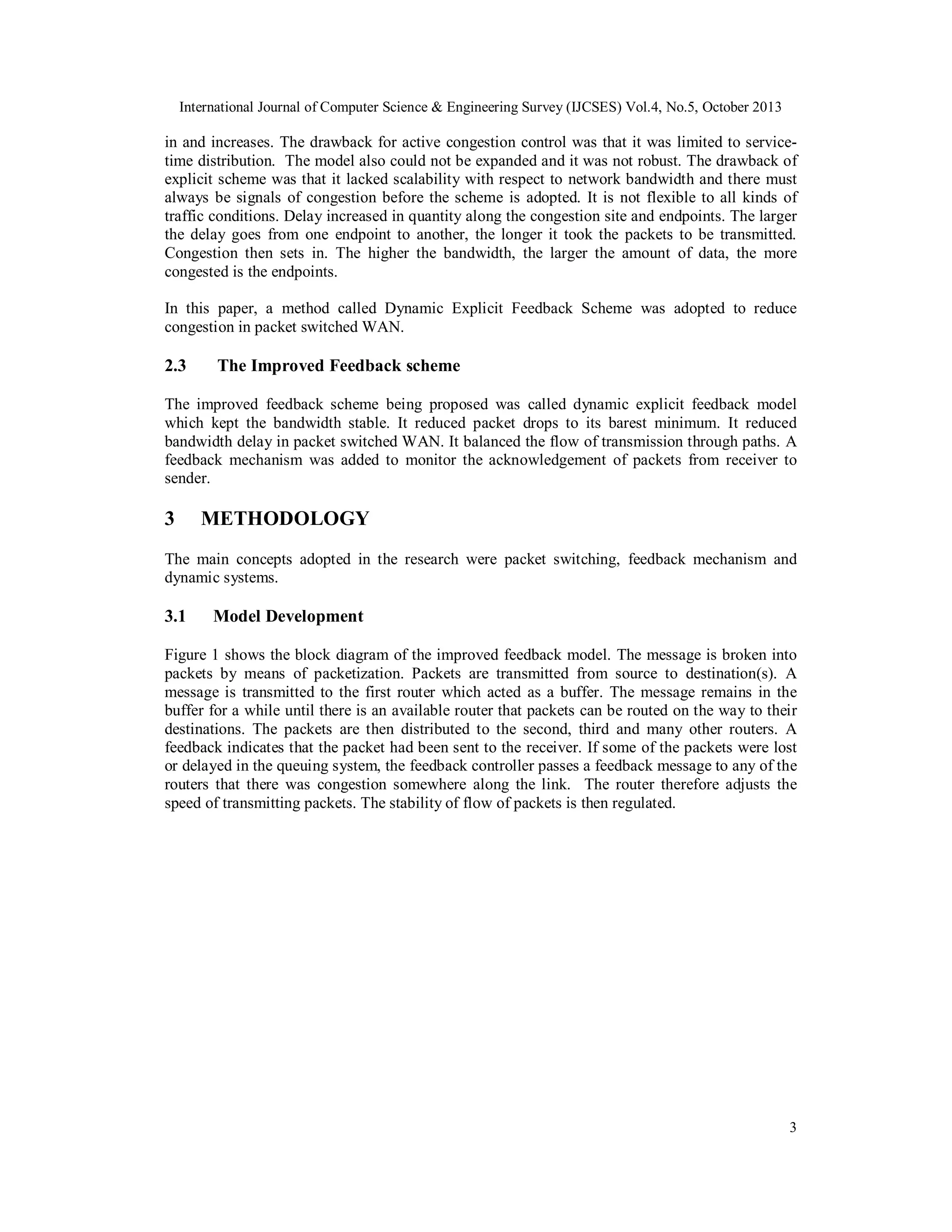
![International Journal of Computer Science & Engineering Survey (IJCSES) Vol.4, No.5, October 2013
Figure 1:Block Diagram for Improved Feedback Model for Managing congestion in Packet Switched Wide
Area Networks
3.2 Model Construction
Queuing model was applied to construct the model [7]. The parameters of the queuing model
were modified and applied to the situation of packet switched WAN. The queuing model for
packet flow in packet switched WAN was then modelled by the following modified parameters:
= rate of arrival of packets
µ = service rate (rate of transmitting packets)
Ls = Average number of users on the network
Lq = Average number of users requesting for web resources from a router in the
network (in the queue).
c = number of routers
ρ = network utilization
Po = Probability of routers that do not accept packets
∞
=
np
(1)
For a single server model (c =1), there is no limit on the maximum number of users in the
network. The model assumes a capacity source. Arrivals occur at rate user per unit time. Under
these conditions, ρ < 1 and < µ. If arrival rate is higher than the service rate, then the geometric
series will not converge and the steady-state probability will not exist. The queue length will
continually increase and no steady state will be reached in the network.
Letting ρ =
, the expression for pn in the generalised model then reduced to
4](https://image.slidesharecdn.com/congestioncontrolinpacketswitchedwideareanetworksusingafeedbackmodel-131111051349-phpapp01/75/Congestion-control-in-packet-switched-wide-area-networks-using-a-feedback-model-4-2048.jpg)
![International Journal of Computer Science & Engineering Survey (IJCSES) Vol.4, No.5, October 2013
Pn = ρn po
, n = 0, 1, 2, -------, n
(2)
To determine the value of po we use the identity
po = (1+ ρ + ρ2 + ----- ρn) = 1
(3)
Assuming ρ < 1,
) the Sum to infinity of
(
a series
where a = 1 and r = ρ
=
=
(4)
=1
For steady state probability
∞
= 1
(5)
= [
= (
]
)
= (1 − )
(6)
For multiple server models which is the case of interest, there are c parallel servers (routers). The
arrival rate is and the service rate per server is µ. There is no limit on the number of routers in
the network. With Kendall’s notation (K∣M∣C):(GD∣∞∣∞), K is the arrival distribution, M is the
service distribution and C is the number of servers in the network. The queue discipline is a
generalized distribution that satisfies all conditions [8]. The parameters considered were arrival
rate ( ), service rate (µ), number of servers (c), probability of number of routers not accepting
packets (Po). Ls and Lq are computed as:
If ρ =
μ and assuming
< 1, the value determined from
=1
Lq was determined in MIMO systems
If ρ =
Then
=
×
(n = 0, 1, 2....., n)
μ
×
×
×
(8)
5](https://image.slidesharecdn.com/congestioncontrolinpacketswitchedwideareanetworksusingafeedbackmodel-131111051349-phpapp01/75/Congestion-control-in-packet-switched-wide-area-networks-using-a-feedback-model-5-2048.jpg)
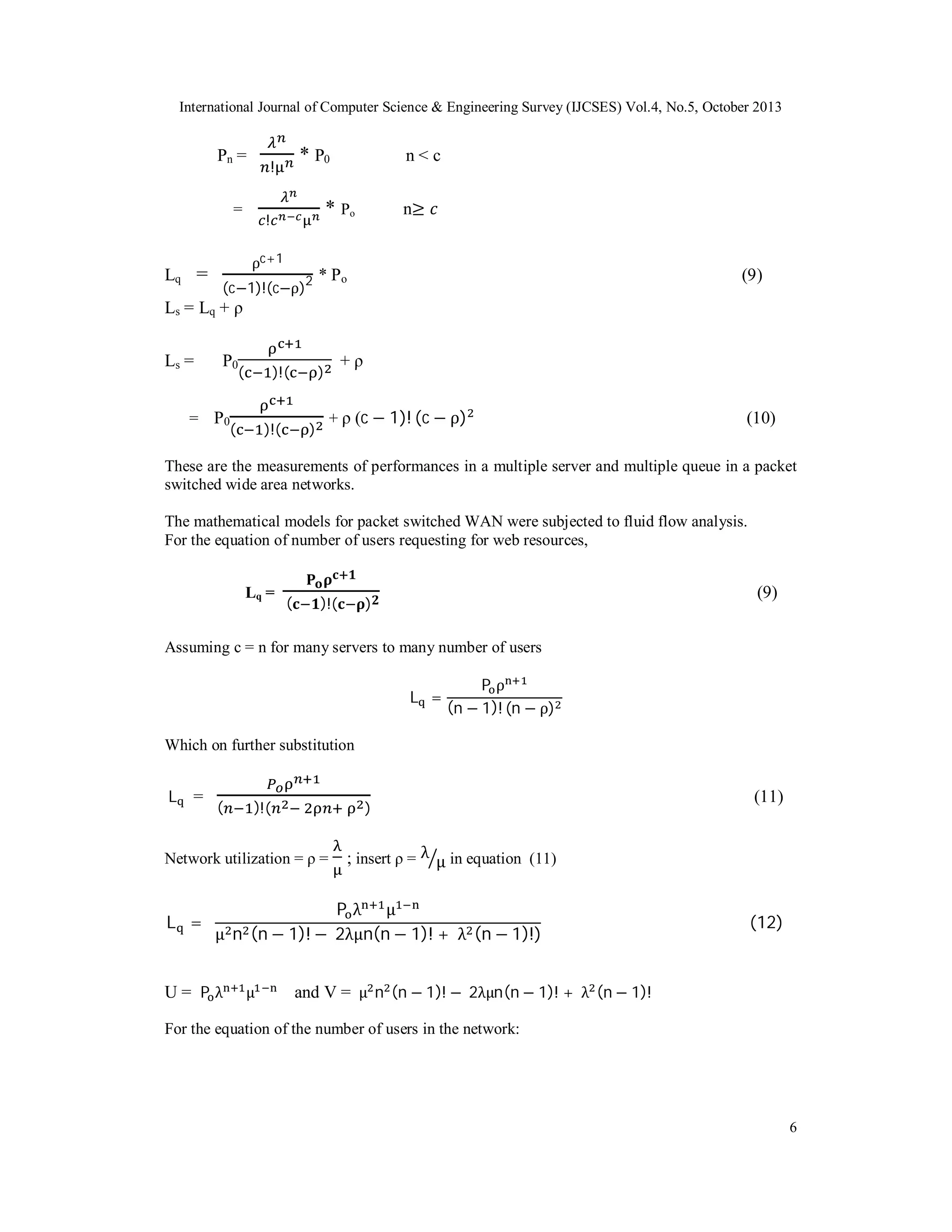
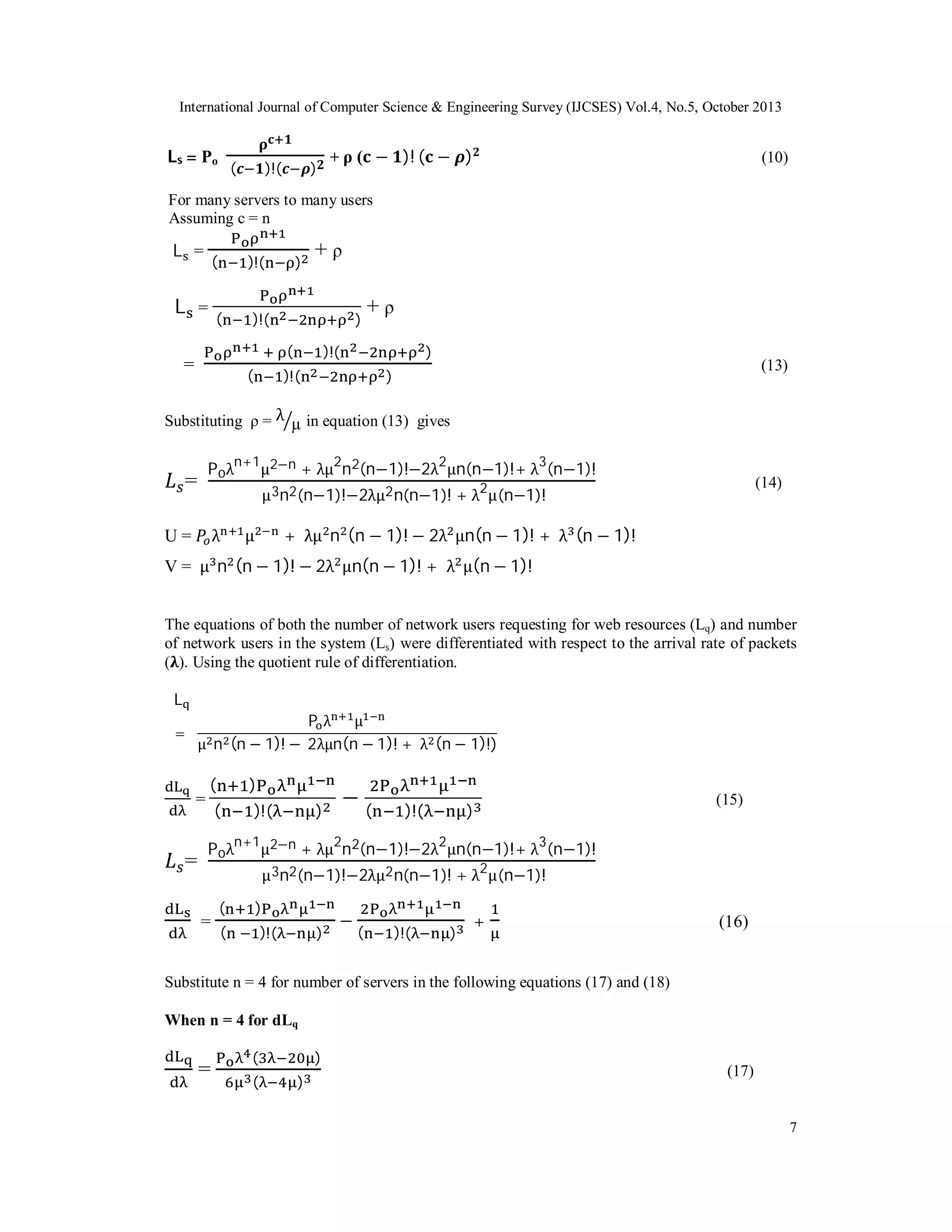
![International Journal of Computer Science & Engineering Survey (IJCSES) Vol.4, No.5, October 2013
When n = 4 for dLs
(
=
)
(
(18)
)
The input and output functions of the differentiated equations with respect to the arrival rate of
packets are not linear and could not be used to find transfer functions. However, one of the
prominent processes for stability analysis in non-linear systems is linearization of equations [9].
The non linear equations were made linear by the process of linearization. Linearization assesses
the local stability of the equilibrium point of non linear equations of dynamic systems .
when y = 0,
Linearization of dLq and dLs for n = 4
y = f(x) + f '(x)(x – )
(19)
substitute f(λ) = 0 in equation (19)
y = f '(x)(x – )
y=
(
(
)
(x – )
)
(20)
when y = 0
x = , At equilibrium point
y = f(x) + f '(x)(x – x0)
(21)
when f(x) = 0
y = f '(x)(x – x0)
when x0 = 0
y = f '(x)(x)
y=
y=
(
(
)
)
(
(
x
)
)
(22)
(x – ), which implies that
x = λ at equilibrium point
y = f(x) + f '(x)(x – x0)
(21)
when f(x) = 0
8](https://image.slidesharecdn.com/congestioncontrolinpacketswitchedwideareanetworksusingafeedbackmodel-131111051349-phpapp01/75/Congestion-control-in-packet-switched-wide-area-networks-using-a-feedback-model-8-2048.jpg)
![International Journal of Computer Science & Engineering Survey (IJCSES) Vol.4, No.5, October 2013
y = f '(x)(x – x0)
when x0 = 0
y = f '(x)(x)
(
y=
)
(
(x)
)
(23)
The Laplace’s transforms for the differentiated linear equation of the number of network users
requesting for web resources and number of users in the system were computed [10]. The
transfer functions of equation was computed from the two Laplace’s transforms of number of
servers n = 4.
Laplace’s transform for
ℒ
=
( ) − ( 0)
(
Y(s) =
)
(
s
)
(
SY(s) =
ℒ
for n = 4
)
(
(
(
=
)
)
)
(24)
Laplace’s transform for
ℒ
=
Y(s) =
SY(s) =
ℒ
=
for n = 4
( ) − (0)
(
)
(
)
(
)
(
(
)
(
)
)
(25)
Transfer function for n = 4
ℒ
ℒ
=
=
(
(
)
(
(
)
(
)
)
)
(
)
(26)
9](https://image.slidesharecdn.com/congestioncontrolinpacketswitchedwideareanetworksusingafeedbackmodel-131111051349-phpapp01/75/Congestion-control-in-packet-switched-wide-area-networks-using-a-feedback-model-9-2048.jpg)
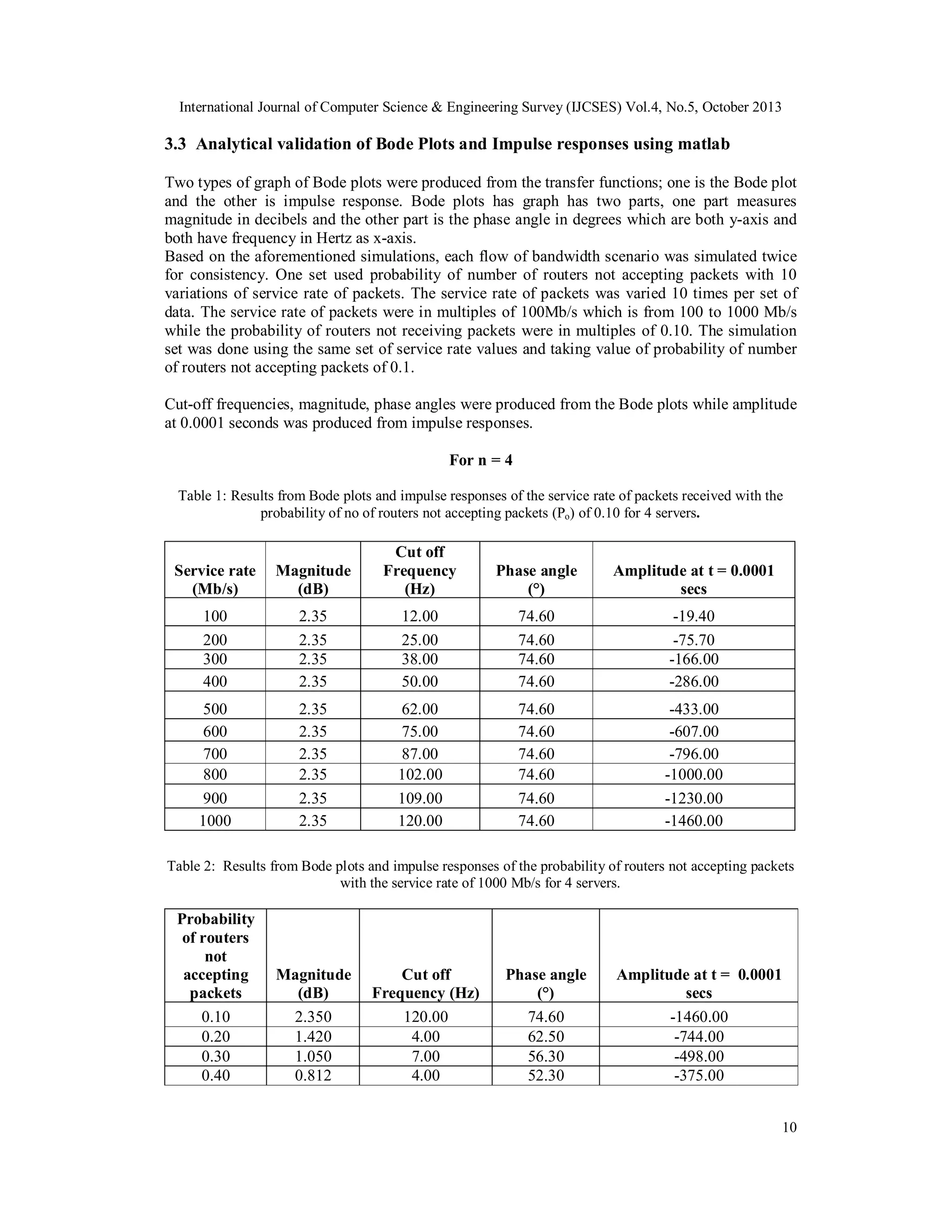

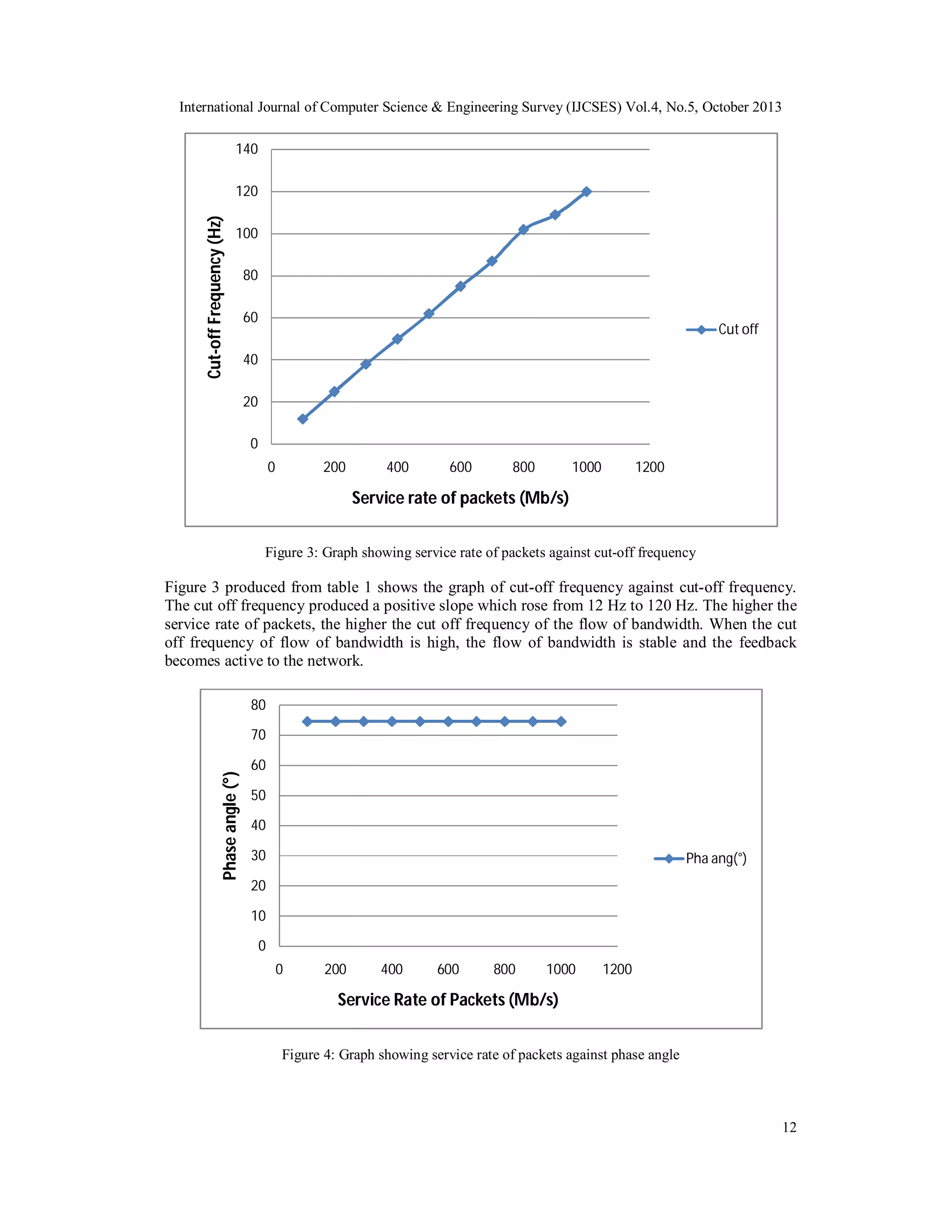
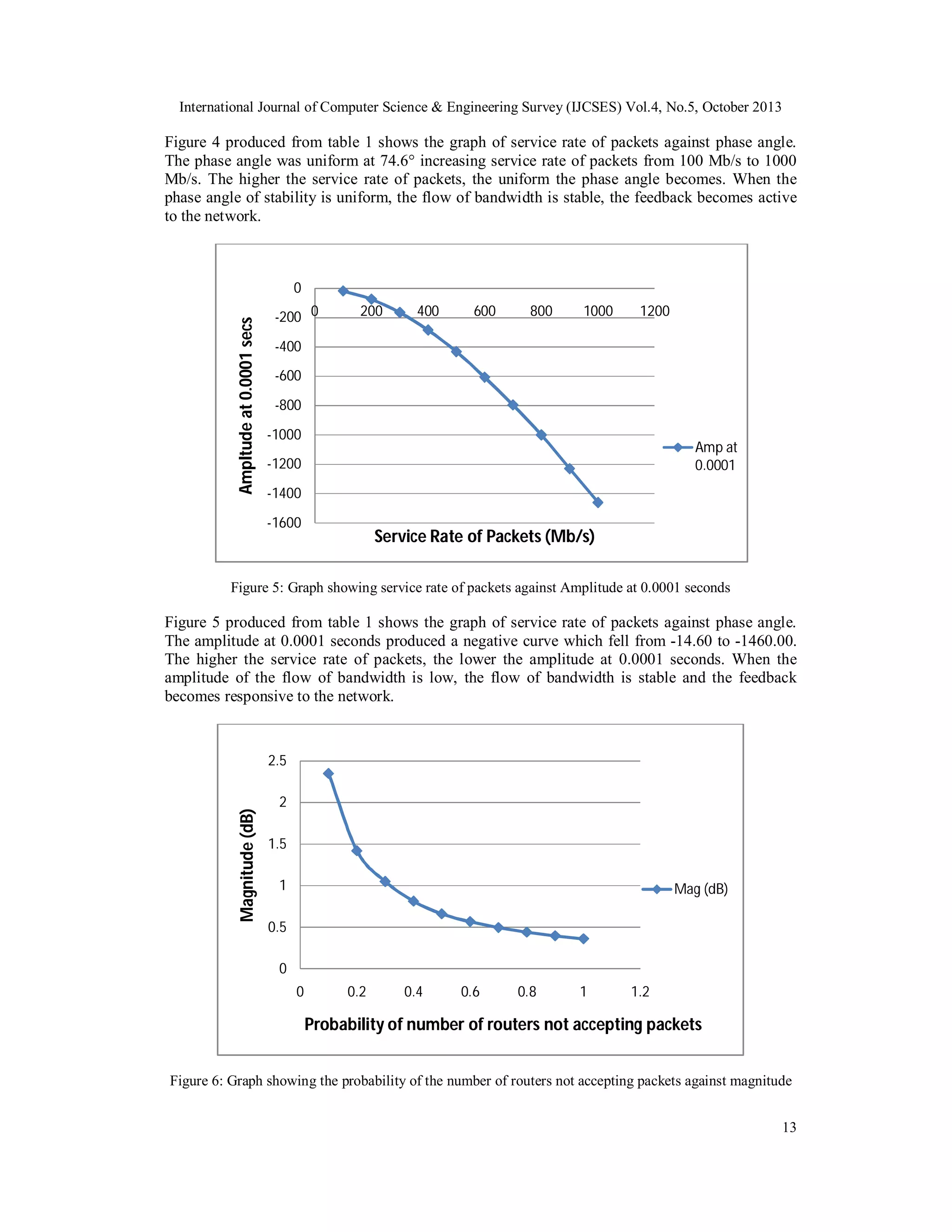
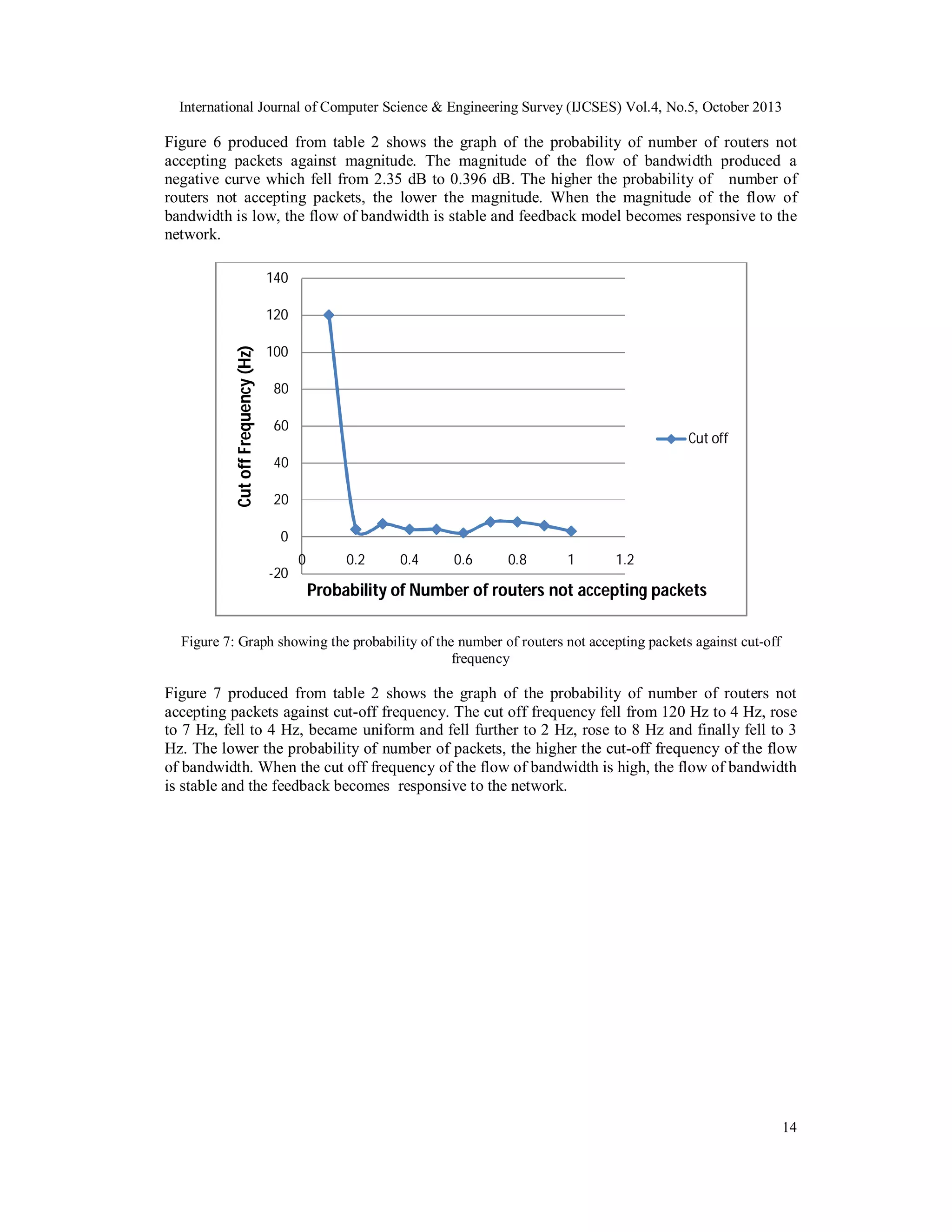
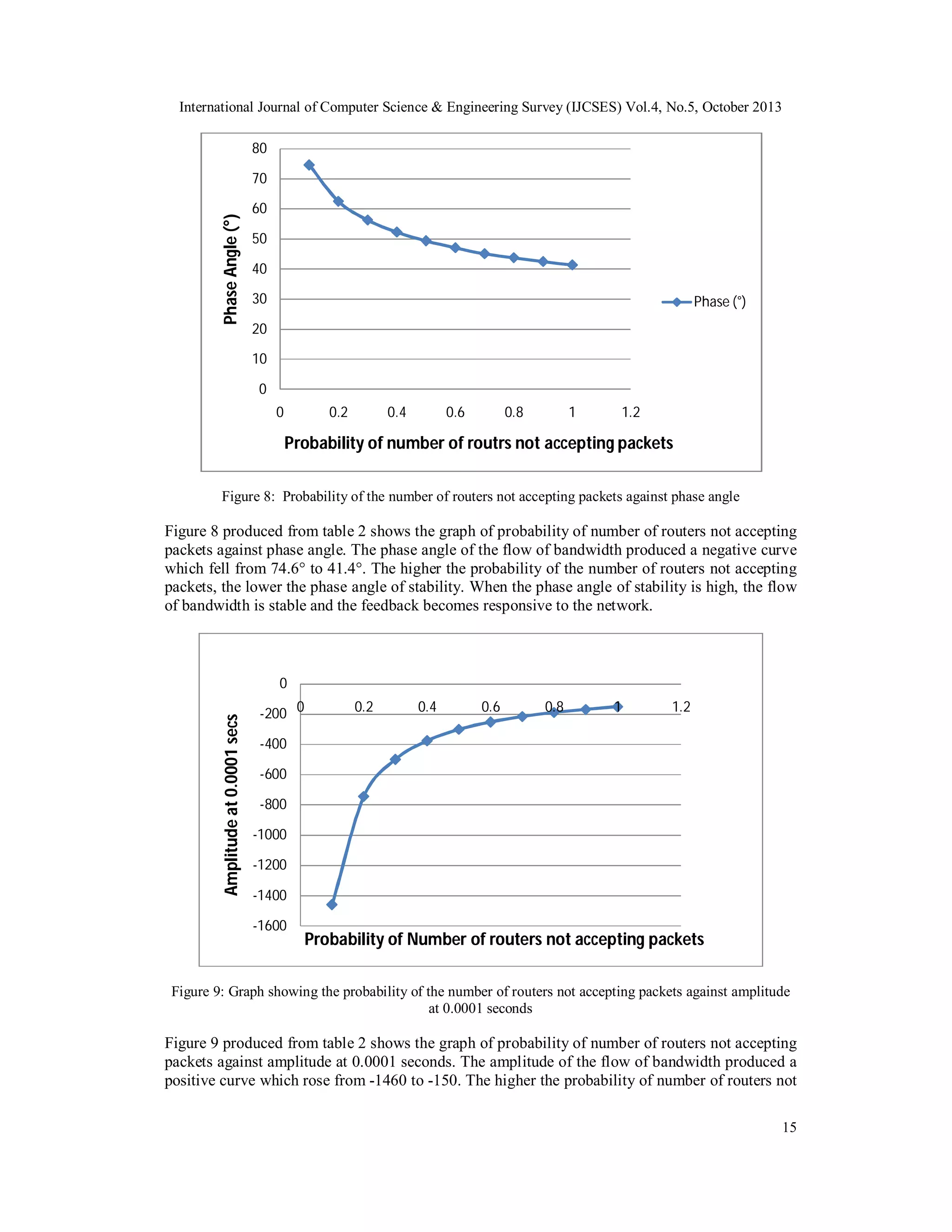
![International Journal of Computer Science & Engineering Survey (IJCSES) Vol.4, No.5, October 2013
accepting packets, the higher the amplitude at 0.0001 seconds i.e. the lower the probability of
number of routers not accepting packets, the lower the amplitude. When the amplitude of the flow
of bandwidth is low, the flow of bandwidth is stable, the feedback becomes responsive to the
network.
5 CONCLUSION
In this paper, a scheme was proposed for improved feedback model for reducing congestion using
TCP protocols at the network layer. The scheme used variable amount of feedback from the
network, with a router to indicate congestion. Each network server that is congested sets the
router and sends message to the source by the user. The message goes back to the source from the
destination which receives packets. The network was modelled as a negative feedback control
system and identified various component in the scheme in the model. The policies that needed to
be used in each of these components were studied through analysis and simulation.
The network servers detect their state as being congested and sets the congestion indication router
when the time to deliver packets the receiver is longer than expected. The arrival rates and
service rate of packets were described. The users receive their packets and determine the flow of
bandwidth stability. The probability of routers accepting packets too also determine the stability
of flow of bandwidth and it is between 0 and 1.
It was also demonstrated that the scheme is distributed, adapts to any state of the network,
converges to fairness, minimizes packet loss and amplitude of oscillation.
The performance of the scheme was addressed under transient changes in the network. The
scheme operates the network at a stable point when the network is overloaded even, when the
users try to cause bottleneck in the path
ACKNOWLEDGEMENTS
The authors would like to thank my parents and my lecturers and colleagues for contributing this
paper in all forms of the other for publication.
REFERENCES
[1]
[2]
[3]
[4]
[5]
[6]
[7]
Hicks, M., (2004), Managing Gigabit Networks, Applications and Services – Compuware; Questnet
2204 Conference Networking Far and Wide Held at Cairns International Hotel, Cairns, Austrailia.
Patternson, D.A., (2001), Network, Spring Lecture Slides; Department of Computer Science,
University of California, Berkeley, U.S.A.
Janarthanan, Y., G. Minden, and J. Evans (2003), Enhancement of Feedback Congestion Control
Mechanisms by Deploying Active Congestion Control; The University of Kansas Centre for
Research, Inc., 2235 Irving Hill Road, Lawrence, KS 66044-7612. U.S.A.
Mamatas L., T. Harks, and V. Tsauossidis, (2007), Approaches to Network Congestion in Packet
Switched Networks; Journal of Internet Engineering, Volume 1, Number 1.
Ramakrishnan, K.K. and R. Jain., (1990), A Binary Feedback Scheme for Congestion Avoidance in
Computer Network; ACM Transactions in Computer Systems, Vol, 8. No. 2. Pages 158-181.
Katabi, D., M. Handley and C. Rohrs, (2002). Congestion Control for High Bandwidth delay Product
Networks, ACM Special Interest Group on Communication, Pittsburgh Supercomputing Center,
U.S.A.
Shor, M.H., Li Kung, J. Walpole, D.C., Steere, Pul Calton., (2003), Application of Control Theory to
Modelling and Analysis of Computer Systems; Department of Electrical and Computer Engineering,
Oregon State University, Corvallis, U.S.A.
16](https://image.slidesharecdn.com/congestioncontrolinpacketswitchedwideareanetworksusingafeedbackmodel-131111051349-phpapp01/75/Congestion-control-in-packet-switched-wide-area-networks-using-a-feedback-model-16-2048.jpg)
![International Journal of Computer Science & Engineering Survey (IJCSES) Vol.4, No.5, October 2013
[8]
Taha, H.A., (2008), Operation Research: An introduction, Eight Edition, Upper Saddle River, New
Jersey, U.S.A. page 538.
[9] http://en.wikipedia.org/linearisation accessed 19th March 2009.
[10] http://en.wikipedia.org/nonlinear_control accessed 19th March 2009.
[11] www.sosmath.com/Linearization_Technique.
[12] Jain, R., K.K. Ramakrishnan, and D. Chiu (1998), Congestion Avoidance with Computer Networks
with a Connectionless Network Layer Part I: Concepts, Goals and Methodology; Digital Equipment
Corporation, 550 King Street (LKG 1-2/A19) Littleton, MA 01460.
[13] http://en.wikipedia.org/wiki/feedback accessed 7th July 2008.
[14] Jain, R., (1998), Congestion Management in High Speed Networks, Issues and Trends, IEEE
Magazine, pp 24-30.
[15] Dorf, R.C. and R.H. Bishop, (2004), Modern Control Systems; Pearson Education, Singapore.
[16] Ghosh, S., (2004), Control Systems: Theory and Applications; Pearson Education, Singapore.
[17] www.nationmaster.com/queuing_theory.
[18] Zabczyk, J., (1992), Mathematical Control Theory: An Introduction; Springer Series, Institute of
Mathematics, Polish Academy of Science, Sniadeckich, office 512, 00-956 Warsaw, Poland.
[19] Bosco, H.L. and D.C. Dowden, (2000), Evolution of Wide Area Networks, Bellab Technical Journals,
5:46 – 72.
[20] Bose, S.J., (2002) Chapter 1 – An Introduction to Queuing systems: Kluwer/Plenum Publishers.
[21] Che, X., D. Hunter, and I. Henning, (2008), Congestion Control over Multiple Time Scales for
Optical Packet Switched Networks; Department of Electronic systems Engineering, University of
Essex, CO43SQ UK.
[22] Constantinescu, D., D. Erman, D. Ilie, and A. Popescu, (2007). Congestion and Error Control In
Overlay networks, Research Report 2007:01, Department of Telecommunications System, School of
Engineering, Blekinge Institute of Technology, S-371 79 Kariskrona, Sweeden.
[23] Fang, Lu, (2006), ATM Congestion Control, http://www.cse.ohio-state.edu/~jaon/cis78895/ftp/tm_cong/index.htm assessed on 13th February, 2006.
[24] Gevros, P., J. Crowcroft, P. Kirstein and S. Bhantti., (2001), Congestion Control Mechanisms and the
Best Effort Service Model; University of London, London.
[25] Hellstein, J. and S. Parekh., (2008), An Introduction to Control Theory with Applications to Computer
Science, IBM; T.J. Watson Research Centre.
[26] http://en.wikipedia.org/packet_switcing accessed 26th May 2010.
[27] http://dsd.lbl.gov/TCP-turing accessed 3rd April 2009.
[28] Jain, R., (2006), Congestion Management in High Speed Networks, Viewed from
(http://www.cse.ohio.state.edu/~jain/cis788-95/fp/atm_cong/index.htm) accessed 13th February,
2006.
[29] Mahajan R., and S. Floyd, (2001), RED-with Preferential Dropping (RED-PD); University of
Washington , AT&T Centre for Internet Research at ICSI (ACIRI), U.S.A.
[30] Pang, A. (2003). Course Content, Spring 2011, Department of Computer Science and Information
Engineering, Graduate Institute of Networking and Multimedia, National Taiwan University, Tapei,
Taiwan.
[31] Penittinen A, (2003), Queuing systems, Lecture Notes: S-38. 145- Introduction to Teletraffic Theory.
[32] Tijms, H.C.,(2003), Algorithmic Analysis of Queues, Chapter 9 in A First Course in Stochastic
Models, Wiley, Chichester.
[33] Williamson C., (2001), Congestion Control and Traffic Management in High Speed Networks;
Department of Computer Science, University of Calgary, 2500 University drive, New Calgary, AB,
Canada T2N, 1N-1.
[34] Xia, Y., L. Subramania, I. Stoica and S. Kalyanaraman (2005). One More Bit is Enough, In
Proceedings of ACM SIGCOMM, Philadelphia, U.S.A.
[35] Yang, R.X., S.L. Lam., (2000), General AIMD Congestion Control; Department of Computer
Sciences, The University of Texas, Austin, Austin, U.S.A.
17](https://image.slidesharecdn.com/congestioncontrolinpacketswitchedwideareanetworksusingafeedbackmodel-131111051349-phpapp01/75/Congestion-control-in-packet-switched-wide-area-networks-using-a-feedback-model-17-2048.jpg)
